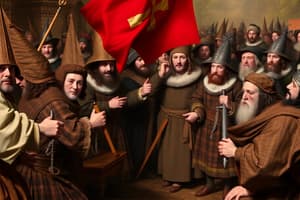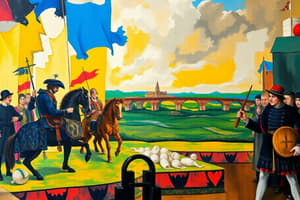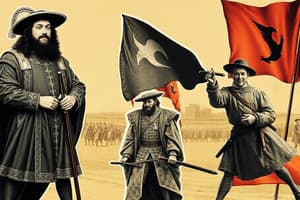Podcast
Questions and Answers
What significant document allowed Maria Theresa to inherit the Austrian throne?
What significant document allowed Maria Theresa to inherit the Austrian throne?
- The Declaration of Rights
- The Act of Settlement
- The Pragmatic Sanction (correct)
- The Treaty of Versailles
Which of the following best describes Frederick the Great's approach to leadership?
Which of the following best describes Frederick the Great's approach to leadership?
- He emphasized absolute power with complete disregard for his subjects.
- He enforced harsh military discipline without compromise.
- He ignored the wishes of the nobility and lost their support.
- He encouraged religious tolerance and sought legal reforms. (correct)
What was a major outcome of the War of Austrian Succession for Prussia?
What was a major outcome of the War of Austrian Succession for Prussia?
- Prussia lost its territories in Silesia.
- Prussia gained recognition as a major power in Europe. (correct)
- Britain intervened to support Austria's claim.
- Austria secured a significant victory over Prussia.
What economic change did Frederick William introduce in Prussia?
What economic change did Frederick William introduce in Prussia?
What was one of the main reasons Maria Theresa faced challenges to her rule?
What was one of the main reasons Maria Theresa faced challenges to her rule?
Which conflict is known as the Seven Years' War in Europe?
Which conflict is known as the Seven Years' War in Europe?
What was a key characteristic of Prussian nobles known as the Junkers?
What was a key characteristic of Prussian nobles known as the Junkers?
Which region did Frederick the Great aim to acquire during the War of Austrian Succession?
Which region did Frederick the Great aim to acquire during the War of Austrian Succession?
What primarily caused the Thirty Years' War?
What primarily caused the Thirty Years' War?
Which leader was pivotal in driving the Hapsburg armies out of northern Germany?
Which leader was pivotal in driving the Hapsburg armies out of northern Germany?
What was one of the outcomes of the Peace of Westphalia in 1648?
What was one of the outcomes of the Peace of Westphalia in 1648?
Which two French Cardinals intervened in the Thirty Years' War due to fears of growing Hapsburg power?
Which two French Cardinals intervened in the Thirty Years' War due to fears of growing Hapsburg power?
What was a significant consequence of the Thirty Years' War on the German population?
What was a significant consequence of the Thirty Years' War on the German population?
What economic structure dominated central Europe compared to western Europe during this period?
What economic structure dominated central Europe compared to western Europe during this period?
Which of the following statements regarding the Hapsburgs during the Thirty Years' War is correct?
Which of the following statements regarding the Hapsburgs during the Thirty Years' War is correct?
What aspect of state formation was introduced by the Peace of Westphalia?
What aspect of state formation was introduced by the Peace of Westphalia?
Flashcards
Thirty Years' War
Thirty Years' War
A period of religious and political conflict in Central Europe from 1618 to 1648, primarily between Protestants and Catholic Hapsburgs.
Bohemian Protestant Revolt
Bohemian Protestant Revolt
The revolt of Protestants against Catholic Hapsburg rulers, specifically Ferdinand II, in 1618, which sparked the Thirty Years' War.
Hapsburgs
Hapsburgs
The ruling family, particularly Ferdinand II, who sought to maintain Catholic power and suppress Protestant uprisings.
Gustavus Adolphus
Gustavus Adolphus
Signup and view all the flashcards
Peace of Westphalia
Peace of Westphalia
Signup and view all the flashcards
Independent States
Independent States
Signup and view all the flashcards
Rise of Modern States
Rise of Modern States
Signup and view all the flashcards
Central European Economy
Central European Economy
Signup and view all the flashcards
Pragmatic Sanction
Pragmatic Sanction
Signup and view all the flashcards
Maria Theresa's Reign
Maria Theresa's Reign
Signup and view all the flashcards
The Rise of Prussia
The Rise of Prussia
Signup and view all the flashcards
Junkers' Role
Junkers' Role
Signup and view all the flashcards
Frederick the Great
Frederick the Great
Signup and view all the flashcards
War of Austrian Succession
War of Austrian Succession
Signup and view all the flashcards
The Seven Years' War
The Seven Years' War
Signup and view all the flashcards
Enlightened Despot
Enlightened Despot
Signup and view all the flashcards
Study Notes
Central European Monarchs Clash
- Tension arose between Lutherans and Catholics in central Europe.
- The Bohemian Protestants revolted against Catholic Habsburg rulers (Ferdinand II) in 1618.
- This revolt triggered the Thirty Years' War, a conflict over religion, land, and power.
The Thirty Years' War (continued)
- Habsburg armies (sometimes spelled Habsburg) achieved many victories between 1618 and 1630.
- Habsburg troops plundered many German villages.
- The Protestant, Gustavus Adolphus of Sweden, with his disciplined army, drove Habsburg armies out of northern Germany, but he was killed in battle.
- French Cardinal Richelieu and Mazarin feared growing Habsburg power more than the Protestants. Therefore, they sent French (Catholic) troops to aid German and Swedish Protestants against the Habsburg armies.
Thirty Years' War (continued)
- The Habsburg domains reached their peak in the mid-16th century, dominating much of Central Europe.
End of the Thirty Years' War
- The war decimated the German economy and drastically reduced its population from roughly 20 million to 16 million.
- Germany's recovery from the devastation took a long time. This prolonged the process of German unification, which occurred in 1871.
- The Peace of Westphalia (1648) concluded the war.
- The treaty recognised Europe as a collection of independent states.
- The Treaty of Westphalia diminished the power of the Habsburgs and strengthened France.
- It marked the end of religious wars in Europe.
- The treaty introduced a concept of negotiating peaceful terms between warring parties.
- The idea of a united Catholic European empire was abandoned.
States Form in Central Europe
- Central Europe's economy remained heavily reliant on agriculture and serfdom. It was rigidly controlled by the landowning nobility. This differed significantly from Western Europe, where cities were evolving into centers of commerce, and a middle class was emerging.
- Several large empires, such as the Ottoman and Holy Roman Empires, in Central Europe were losing strength.
- Landowning nobles in Central Europe prevented the growth of royal power within their regions and empires.
Rise of the Austrian Empire
- The Habsburg family's Austrian branch expanded its territories and established a large empire.
- Ruling a diverse empire with numerous ethnic groups posed a significant challenge.
- Emperor Charles VI ensured his daughter, Maria Theresa, inherited the throne through the Pragmatic Sanction.
- Maria Theresa, Empress of Austria, faced challenges and conflicts after inheriting the throne.
Pragmatic Sanction
- This document legally established Maria Theresa as the heir to the Austrian throne.
Maria Theresa of Austria
- Known for her daughter Marie Antoinette.
- Reduced the influence of the nobility.
- Worked towards improving the conditions of serfs.
Prussia Challenges Austria
- The Hohenzollern rulers of Prussia developed Europe's most powerful army.
- Prussian rulers called themselves kings and established absolute monarchies.
- Frederick William introduced permanent taxation, giving Prussian nobles, the Junkers, exclusive officer ranks in the Prussian army, in exchange for their loyalty.
- Frederick the Great became king and continued his father’s military policies. He modified some of his laws to maintain stability.
Frederick II (The Great)
- King of Prussia, nicknamed "Old Fritz".
What Makes Frederick Great?
- He supported religious tolerance and legal reforms.
- He believed a ruler should act like a father figure to his people. This earning him the reputation of an "Enlightened Despot."
Prussia Challenges Austria: The War of Austrian Succession
- In 1740, Frederick II initiated a war against Austria to seize Silesia, an area rich in resources like iron ore, textiles, and food.
- Maria Theresa initially resisted but was ultimately forced to concede Silesia in a treaty.
- This war established Prussia's position as a major European power.
Prussia Challenges Austria: The Seven Years' War
- Austria allied with France against Britain and Prussia.
- In 1756, Frederick II attacked Saxony. This set off the Seven Years' War.
- This war, also known as the French and Indian War in North America, did not lead to significant territorial changes in Europe.
- France lost colonies in North America, and Britain gained control of India.
Studying That Suits You
Use AI to generate personalized quizzes and flashcards to suit your learning preferences.



